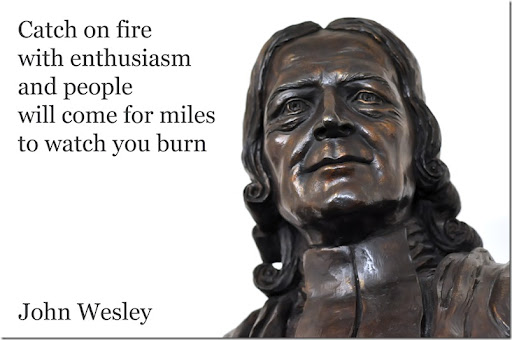When the General Conference of the United Methodist Church comes around every four years, myths about John Wesley show up in full force.
 Sometimes these myths show up on the swag handed out. Tote bags and t-shirts that include Wesley mis-quotes like “Catch on fire with enthusiasm and people will come for miles to watch you burn” have been around for decades.
Sometimes these myths show up on the swag handed out. Tote bags and t-shirts that include Wesley mis-quotes like “Catch on fire with enthusiasm and people will come for miles to watch you burn” have been around for decades.
Other times these myths show up in theological dialogue. Many United Methodist Churches defend the practice of inviting anyone, including people of other religions and those who are un-baptized, to the communion table by arguing that Wesley taught and practiced this same exact thing.
And still at other times Wesleyan  myths are the basis for the whole conference, such as in 1996 when the theme was the quote by Wesley that has never been found in his works, “In Essentials Unity, In Non-Essentials, Liberty, In All Things Charity.”
myths are the basis for the whole conference, such as in 1996 when the theme was the quote by Wesley that has never been found in his works, “In Essentials Unity, In Non-Essentials, Liberty, In All Things Charity.”
As I’ve studied Methodism throughout seminary, I’ve found myself drawn to Wesley’s biography and writings. Reading primary and secondary sources surrounding this great man of the faith has proven edifying for my ministry and me.
Yet, in my studies of Wesley, I’ve noticed an unpleasant truth. It’s one that commonly surrounds historical figures—including the likes of Bonhoeffer, Martin Luther King Jr., and Jesus.
People love to re-create historical figures for their own purposes.
Re-creating figures in this way is very tempting. After all, what better way to justify or promote one’s own theological, political, or social agenda than to appeal to a historical figure that is beloved by all?
If the beloved historical figure is actually in agreement with what you’re advocating, then appealing to them is a strong strategy.
But if you’re stretching historical evidence, projecting modern questions and ideas into historical contexts, or simply parroting what others have told you about a great figure, then I think there are better ways to make your case.
I like to appeal to Wesley when working out my theology, so I’m often in danger of re-creating him in my theological likeness.
Re-creation can occur willfully or unknowingly. It may be done willfully by proof-texting random quotes from his writings that agree with me or by emphasizing aspects of his early theology I like even though I know he changed his beliefs on the issue later in life. It may be done unknowingly by simply perpetuating claims or quotes that other people have said about him.
Sometimes the perpetuation of Wesleyan myths is inconsequential. If it is in basic agreement with his theology and doctrine, does it really matter if Wesley didn’t actually say, “Do all the good you can, by all the means you can, in all the ways you can, in all the places you can, at all the times you can, to all the people you can, as long as ever you can”?
Other times the perpetuation of Wesleyan myths has great consequences. If the UMC is using Wesley as a main source of argument for certain theological beliefs and practices that he would be in disagreement with, the record should be set straight. Employing false church tradition in our thinking process is not helpful. Clearing the air of misinformation such as this enables the church to decide more faithfully what to think and do in today’s context.
In an upcoming blog series, I will explore some of the common myths surrounding Wesley. You may read some of the debunked myths and find them inconsequential. You may read some of the others and find them of great consequence. My goal in this series is not to crush sacred stories with a sledge hammer for academic fun. My goal is that as you learn more about Wesley you would cultivate a desire to study more about him for yourself.
This series will largely be based on a recent interview I did with Dr. Richard Heitzenrater. Dr. Heitzenrater is known for “breaking the code” of Wesley’s diaries that were written in shorthand. He is also regarded for giving these transcoded diaries as a gift to the church, serving as the General Editor of the Bicentennial Edition of the Works of John Wesley, authoring 16+ books, and chairing the Committee on Our Theological Task that wrote the present doctrinal statement in Part II of The Book of Discipline of the United Methodist Church.
I had the opportunity to study “The Life and Times of the Wesleys” under Dr. Heitzenrater last fall at Duke Divinity School. Throughout the class, I loved recording his anecdotes. Two of my favorites are “Anything since the 18th century is just current events” and “Almost every internet source is suspect.” The second quote should lead you to take even my words with a grain of salt.
Up first in this series is the myth held tightly and taught widely…. the myth of the “Wesleyan” quadrilateral.
Post 1: The Myth of the “Wesleyan Quadrilateral”
Post 2: Things John Wesley never said
What things about Wesley have you heard that you later found to be untrue? What things about Wesley are you still wondering about?